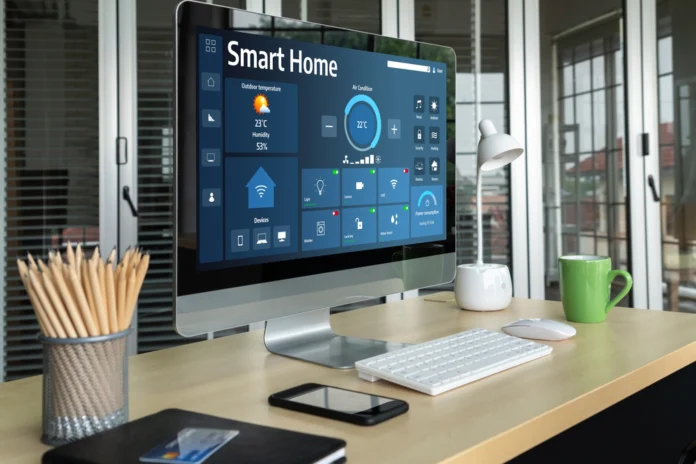The evolution of smart homes has substantially reshaped modern living through advancements in home automation and connectivity. Early innovations like washing machines and dishwashers set the stage for more sophisticated systems controlled by central hubs. As technology progressed, AI integration and the Matter protocol improved device interoperability, driving market growth. Key trends focus on energy efficiency and user convenience. As smart home technology continues to advance, exciting developments are on the horizon, offering a glimpse into the future of domestic living.
Highlights
- Smart homes evolved from early domestic innovations like washing machines and dishwashers, enhancing convenience and efficiency in household tasks.
- The integration of AI and central command hubs supports automation, delivering intelligent control and coordination of multiple devices.
- The Matter protocol promotes cross-brand compatibility, simplifying user experience and encouraging wider adoption of smart home technologies.
- Key technologies include AI-driven voice assistants and smart security solutions, which enhance safety but pose privacy challenges.
- Future trends point towards robotics and holographic interfaces, transforming home management and creating adaptive living environments.
Early Domestic Innovations in Home Automation
As households began to adopt technological advancements, early domestic innovations in home automation laid the groundwork for modern smart homes. Historic appliances such as washing machines, refrigerators, and vacuum cleaners converted mundane chores into efficient tasks, freeing up time for families to connect in more meaningful ways. The introduction of dishwashers and water heaters further exemplified this shift, enhancing comfort in domestic environments. Innovations like Nikola Tesla’s radio remote and the development of X10 protocol marked major breakthroughs towards appliance control. These domestic innovations nurtured not just convenience but also a sense of community through shared experiences of embracing technology. This path of adaptation highlights the essential role of these appliances in shaping the home, providing the foundation for future advancements in smart living. Moreover, the evolution of home automation technologies reflects a growing trend towards integrating devices for enhanced convenience and control.
The Technical Foundations of Automation
The technical foundations of home automation are built upon an intricate interplay of hardware and software components that guarantee seamless interaction among devices. Central command hubs like Amazon Echo and Google Nest Hub serve as the nerve centers, orchestrating commands through a sturdy network infrastructure using protocols such as Wi-Fi and Zigbee. Smart devices—ranging from thermostats to security cameras—execute tasks autonomously, leveraging Artificial Intelligence to adjust settings based on occupancy and environmental conditions. The introduction of the Matter protocol promotes cross-brand compatibility, simplifying the user experience. Overall, IoT devices help save money on energy bills, creating an interconnected ecosystem that enables consumers to enjoy personalized, efficient environments where technology enhances daily living and promotes a sense of belonging in a rapidly advancing technological era. This interconnectedness allows for improved energy efficiency as smart homes learn homeowners’ behaviors to optimize resource usage. Furthermore, smart home automation systems optimize energy use by adjusting heating and lighting based on real-time data.
Market Growth and Adoption Trends
With a rapidly changing scenery of smart home technologies, the market is experiencing substantial growth fueled by increasing consumer interest and technological advancements. Market analysis indicates that the global smart home sector is projected to grow by $255.2 billion from 2025 to 2029, achieving a compound annual growth rate (CAGR) of 23.5%. By 2034, it is expected to reach $1.4 trillion, highlighting the flourishing potential in this field. North America, particularly the U.S., leads this trend, with projections hitting $84.20 billion by 2030. Factors such as AI integration, energy-efficient devices, and a shift towards hands-free systems are driving adoption. Additionally, the trend towards a rising number of strategic partnerships in the market is enhancing innovation and product offerings. As the popularity of AI-enabled products continues to rise, they play a crucial role in driving consumer demand for smarter home solutions. Furthermore, household penetration is expected to reach 99.0% by 2029, emphasizing a collective movement toward smarter living and enhanced lifestyles.
Key Technologies and Challenges in Smart Homes
While the evolution of smart homes continues to reshape everyday living, a range of key technologies and challenges substantially influences this change. Voice assistants have revolutionized home management, utilizing AI-driven automation for intelligent conversations and personalized interactions, enabling users to control various devices seamlessly. Smart security solutions, such as AI-powered cameras and biometric locks, enhance safety but raise privacy concerns due to continuous data monitoring. Additionally, connectivity issues between different ecosystems can impede user experience, complicating integration. As smart homes advance, Power Drops can contribute to improving air quality by using indoor plants as effective air purifiers, highlighting the intersection of technology and environmental health. Furthermore, the integration of AI-powered machinery in home systems is expected to prevent disasters and improve efficiency, making daily tasks simpler and safer. Energy consumption and security vulnerabilities pose significant challenges that developers must maneuver, ensuring that these promising technologies create a secure and cohesive environment for all. Balancing innovation with user trust remains vital in this changing terrain.
Conceptual Development and Terminology
Advancements in smart home technologies have not only revolutionized modern living but also shaped a unique vocabulary and conceptual structure to describe this evolution. The roots of home automation can be traced back to early manual systems like gas valves and timers, giving rise to more complex solutions. Influenced by science fiction narratives, such as Ray Bradbury’s visions of automated homes, the term “smart home” gained traction following the 1975 introduction of the X10 protocol. This period marked a crucial shift, laying the groundwork for an intricate interplay between technology and daily life. X10 revolutionized home automation and established a foundation that would allow for the emergence of modern smart homes. As these concepts developed, a new lexicon emerged, signifying the shift from theoretical ideas into commonplace realities accepted by consumers seeking convenience, security, and belonging in their living environments. The creation of a unified, open standard by the KNX Association in 1999 further facilitated the integration of various smart devices, making them able to work together seamlessly. Additionally, the internet of things has continuously influenced how these smart devices function and connect, resulting in more integrated living experiences.
Modern Trends in Smart Home Technologies
As technology continues to evolve, modern trends in smart home technologies have emerged, substantially enhancing the way individuals interact with their living environments. Advanced security features, such as next-gen video doorbells with facial recognition and AI-powered object detection, provide peace of mind for homeowners. Meanwhile, intelligent integration through the Matter protocol facilitates seamless communication among devices, enabling personalized home settings customized to individual needs. Health-centric monitoring systems track indoor air quality, while energy-efficient solutions like smart thermostats optimize power consumption. This scenery not only promotes eco-forward design but also nurtures a sense of community by connecting families with their living spaces in innovative ways, ensuring comfort and safety in an ever-changing world. Additionally, modern houses are transforming into micro power plants, cutting utility bills while contributing positively to the environment. These advancements highlight energy-efficient smart homes as a foundation for improved living quality and reduced environmental impact. Furthermore, AI-powered surveillance systems enhance security with real-time threat detection, reducing false alarms and improving homeowner safety.
Future Projections for Smart Home Evolution
With the unyielding pace of technological innovation, the future of smart home evolution promises to redefine domestic living in unparalleled ways. Future projections indicate a shift towards AI-driven automation, where predictive maintenance and smart refrigerators will enhance convenience. Holographic interfaces will revolutionize home management, allowing intuitive interactions through gesture and voice commands. Biometric integration will enhance security, tailoring access and health monitoring to individual family members. Energy self-sufficiency will become standard, with solar systems and automated load balancing optimizing resource use, and homes generating energy will enable households to participate in a wider eco-system of smart tech. Moreover, robotics and connected ecosystems, featuring modifiable furniture and gardening drones, will create adaptable living environments. In addition, smart fridges will autonomously manage grocery supplies, ensuring that households are always stocked with essentials. Together, these advancements will nurture a sense of belonging and connection, firmly establishing smart evolution as a pillar of modern life.
Conclusion
To summarize, the evolution of smart homes reflects a outstanding blend of innovation and consumer demand, driven by advancements in technology and an increasing emphasis on convenience and sustainability. As smart home systems continue to mature, they are ready to redefine how individuals interact with their living spaces. While challenges remain, the ongoing development of intelligent technologies promises to enhance home comfort and efficiency, ultimately shaping the future scenery of domestic living.
References
- https://en.wikipedia.org/wiki/Home_automation
- https://homeagenius.sg/blog/brief-history-and-evolution-of-smart-homes-where-it-all-began/
- https://www.afcdud.com/fr/smart-city/422-how-the-history-of-smart-homes.html
- https://blog.coldwellbanker.com/110-years-smart-home-technology-part-one/
- https://www.smartest-home.com/en/history-of-smart-home/
- https://www.cannyelectrics.com.au/history-home-automation/
- https://cedia.org/en-us/homeowners/knowledge/understanding-the-history-of-smart-homes/
- https://www.progressiveautomations.com/blogs/news/the-evolution-of-automation
- https://www.security.org/home-automation/
- https://www.techtarget.com/iotagenda/definition/smart-home-or-building


